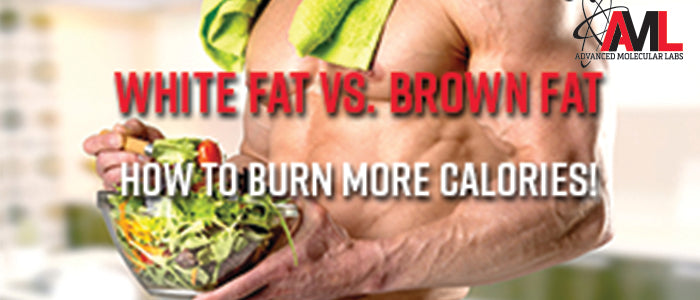


Brown Fat vs White Fat: Key Differences Explained
By Steve Blechman
The body has two forms of fat - brown fat versus white fat. Brown fat burns calories, and the more brown fat you have, the more calories you burn. The capability of harnessing one's own brown fat for fat burning is revolutionary! The ability to get lean by producing extra brown fat and enhancing and activating existing brown fat, known as brown adipose tissue (BAT), represents a promising way to burn fat. Understanding the concept of brown fat vs white fat is essential for those looking to optimize their metabolic health.
Understanding the differences between brown fat versus white fat is crucial for metabolic health. Brown fat is metabolically active and helps in burning calories, while white fat stores energy. Leveraging brown fat's calorie-burning capabilities can significantly impact weight management and overall health. So, what is the difference between brown fat and white fat? Brown fat actively burns energy, whereas white fat serves as an energy reserve.
Mounting evidence suggests that exposure to cold temperatures can enhance brown fat activation and thermogenesis. It can also convert white fat into brown fat and enhance glucose metabolism, insulin sensitivity, and fat metabolism. Cold exposure promotes BAT-induced thermogenesis and energy expenditure, which is crucial for metabolic health. This process highlights the dynamic nature of brown vs white fat in maintaining a healthy metabolism.
In a study led by Denis Blondin from the University de Sherbrooke in Sherbrooke, Canada, male adults exposed to cold via a water-cooled suit for two hours per day, five days per week for four weeks increased brown fat (BAT) volume by 45 percent and resting metabolism by 182 percent. The human body contains small amounts of fat that convert food energy directly into heat. White fat does the opposite - it stores energy as fat. BAT is an important heat-generating tissue in hibernating animals. It promotes non-shivering thermogenesis, which generates heat and helps animals and humans adapt to the cold. Individual differences in BAT content and activity play important roles in human obesity. Increasing brown fat activation promotes caloric expenditure and fat burning. Cold exposure may be an effective way to reduce body fat.
There are several practical ways to increase cold exposure:
- Turn down the thermostat in your home.
- Keep the air conditioning at high levels during the summer.
- Try swimming in a cold pool or the ocean.
- Wear less clothing in the winter.
- Take cold baths or showers.
- After a warm shower, place the showerhead on your neck and shoulders and turn on the cold water directly on your shoulder blades. This will activate brown adipose tissue (BAT) in the scapula region of the neck and shoulder blades.
The cold will activate brown fat thermogenesis and energy expenditure. It's quite invigorating, but only recommended for healthy individuals because cold exposure can induce sympathetic nervous system activity, cause vasoconstriction, raise blood pressure in susceptible individuals, and is not recommended for those with cardiovascular disease or hypertension.
Another common approach is taking a hot sauna followed by a cooling bath or shower. The sauna has been shown to release growth hormone, which enhances lipolysis and fat oxidation, while the cold exposure will enhance BAT metabolism and increase energy expenditure.
In the wintertime, working out in the cold weather is a great way to enhance BAT and convert white fat to brown fat. However, since cold exposure is not practical for most people and not well-tolerated, especially for those who are not healthy or have cardiovascular disease, alternative methods are necessary. More heart attacks have been shown to occur in northern climates during cold exposure (winter) than in southern regions where the climate is warm, like the "snowbirds" who travel from the cold weather to the warm weather in Florida.
The latest extreme cold-exposure trend, cryotherapy, involves being encased below the neck in a tank that is minus 300 degrees Fahrenheit. These full-body cryotherapy chambers, as they are called, are thought to promote weight loss, pain recovery, mood enhancement, and relieve muscle soreness. Cryotherapy centers are opening around the country.
However, there is no scientific evidence to show that cryotherapy increases brown adipose tissue (BAT), thermogenesis, and weight loss. A six-month study of moderate aerobic activity combined with whole-body cryotherapy did not change body mass, fat, or lean body mass percentages. The experiment was performed on 45 overweight and obese men.
Celebrity athletes like Lebron James and Shaquille O'Neill have touted their benefits. Cryotherapy operators are called "cryo-therapists."
Some deaths have been reported from using cryotherapy, and while the reasons aren't clear, the FDA (U.S. Food & Drug Administration) noted on June 5, 2016, in a report that while cryotherapy may be a "cool" trend, it poses risks. The FDA stated in their report that, "Given a growing interest from consumers in whole body cryotherapy, the FDA has informally reviewed the medical literature available on this subject," says Aron Yustein, M.D., a medical officer in the FDA's Center for Devices and Radiological Health. "We found very little evidence about its safety or effectiveness in treating the conditions for which it is being promoted."
Because cold is not a practical approach for increasing brown fat activation and weight loss for most people, and it may not be pleasant or safe, diet, exercise, and certain supplements to increase brown fat would be a better approach than cold exposure.
The Thermo Heat Weight Loss Revolution is a groundbreaking scientific plan based on research involving brown fat (BAT). The Thermo Heat Weight Loss Revolution offers its readers thermogenic and brown fat-activating dietary supplements such as Advanced Molecular Labs (AML)'s Thermo Heat: the original and most advanced thermogenic and brown fat activator ever developed! This plan also includes guidance on how to increase brown fat naturally through diet and exercise.You can also get a PDF version of The Thermo Heat Weight Loss Revolution e-book here by Michael J. Rudolph, Ph.D, including the foreword by Daniel L. Friedman, MD and Eugene B Friedman, MD.
Additionally, a section of this book is devoted to appropriate brown fat-activating exercise programs and food choices, plus an easy-to-follow 30-day thermogenic, fat-burning meal plan.
The book recommends readers follow a low-carb, anti-inflammatory Mediterranean Diet. Recent research has shown that inflammation inhibits the conversion of white fat into beige and brown fat. The low-carb Mediterranean Diet is also best for optimal health and weight control. Followers of this scientifically developed program will find that they are able to harness the power of brown fat, maximize their energy expenditure, attain, and then maintain their ideal weight, and achieve the reduction of body fat and preservation of lean muscle they are looking for.
References:
1. Blondin, D. P., Daoud, A., Taylor, T., Tingelstad, H. C., Bézaire, V., Richard, D., Carpentier, A. C., Taylor, A. W., Harper, M.-E., Aguer, C. and Haman, F. (2017), Four-week cold acclimation in adult humans shifts uncoupling thermogenesis from skeletal muscles to brown adipose tissue. J Physiol, 595: 2099-2113. doi:10.1113/JP273395
2. Lubkowska, A., Dudzinska, W., Bryczkowska, I., and Dolegowska, B. (2015). Body composition, lipid profile, adipokine concentration, and antioxidant capacity changes during interventions to treat overweight with exercise programme and whole-body cryostimulation. Oxid. Med. Cell. Longev. 2015:803197. doi: 10.1155/2015/803197
3. Whole Body Cryotherapy (WBC): A "Cool" Trend that Lacks Evidence, Poses Risks https://www.fda.gov/ForConsumers/ConsumerUpdates/ucm508739.htm
4. Peake, J. M., Roberts, L. A., Figueiredo, V. C., Egner, I., Krog, S., Aas, S. N., Suzuki, K., Markworth, J. F., Coombes, J. S., Cameron-Smith, D. and Raastad, T. (2017), The effects of cold water immersion and active recovery on inflammation and cell stress responses in human skeletal muscle after resistance exercise. J Physiol, 595: 695-711. doi:10.1113/JP272881
5. Obesity Reviews May 25, 2017 published August 1, 2017 Obesity Reviews July 14, 2017 Human brown adipose tissue as a target for obesity management; beyond cold-induced thermogenesis http://onlinelibrary.wiley.com/doi/10.1111/obr.12584/abstract
6. Obesity Reviews May 25, 2017 published August 1, 2017 Non-shivering thermogenesis as a mechanism to facilitate sustainable weight loss http://onlinelibrary.wiley.com/doi/10.1111/obr.12563/full
7. Obesity Reviews February 10, 2017 Factors involved in white-to-brown adipose tissue conversion and in thermogenesis: a review http://onlinelibrary.wiley.com/doi/10.1111/obr.12520/full





